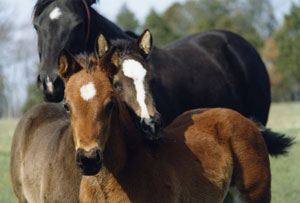 The birth mare had never been the warm and fuzzy type, even before she became pregnant.
The birth mare had never been the warm and fuzzy type, even before she became pregnant.
She was the dominant mare in the herd and routinely showed her alpha attitude toward other horses and people. Unfortunately, her abrasive behavior increased exponentially after she foaled. The combination of hardwired surliness and protective maternal instinct turned her into a stall shark. You know the kind – snaky neck, ears pinned, teeth bared, and circling the stall like a barracuda on the prowl.
In the event of an orphan foal, there are certain crucial steps you must take within the first few hours of the foal’s life. Review the steps in the AQHA Orphan Foal Care report.
We dipped the navel of the foal after birth and barely managed to collect a blood sample for measuring antibody concentrations at 36 hours of age.
Fortunately, the level was fine. We couldn’t imagine giving plasma while attempting to hold onto a 1,000-pound piranha. After that, no one dared to enter the foaling stall. Not even on a double-dare.
A debate ensued as to what to do with the mare and newborn foal. Then the mare made the decision easy. She bit the vet. And it wasn’t just a nip. The unanimous vote was to move the foal onto a nurse mare. The vet would have voted, but he couldn’t raise his arm.
Potential options included a mare who had just weaned her own foal, a mare who had just lost her foal or inducing lactation in a nonpregnant mare.


You must be logged in to post a comment Login